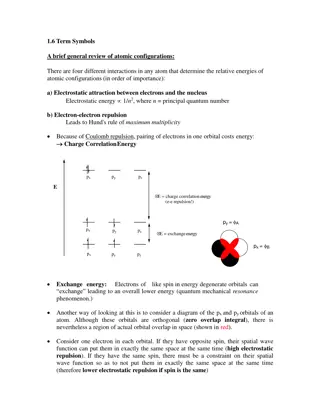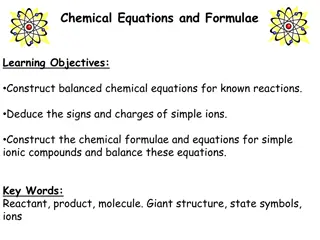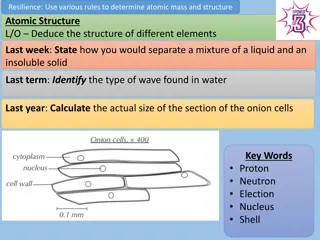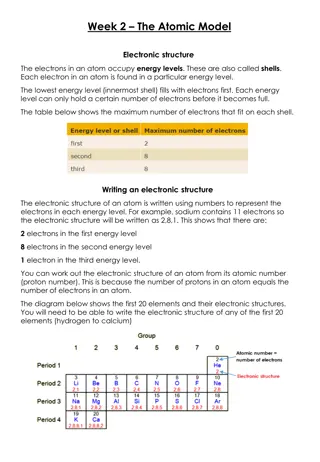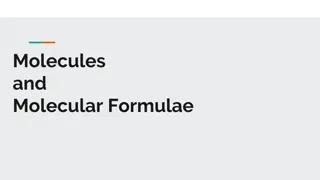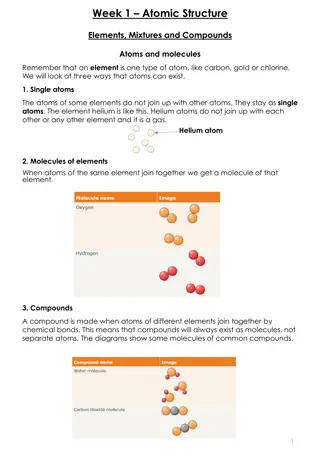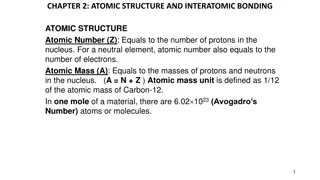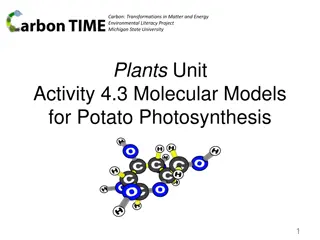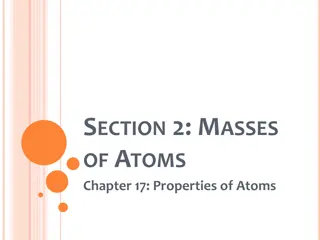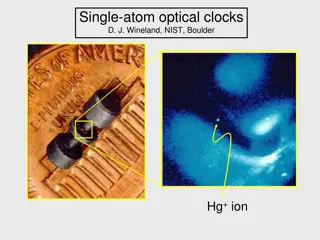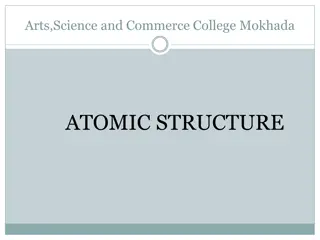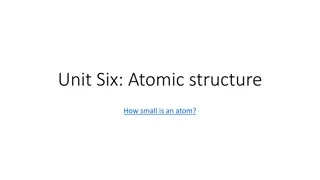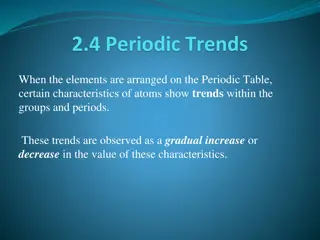
Atomic Structure and Chemical Symbols in Physical Science
Explore the intricacies of atomic structure, including the atomic number, mass number, isotopes, and chemical symbols in physical science. Learn how to determine the composition of atoms and understand their properties.
Download Presentation

Please find below an Image/Link to download the presentation.
The content on the website is provided AS IS for your information and personal use only. It may not be sold, licensed, or shared on other websites without obtaining consent from the author. If you encounter any issues during the download, it is possible that the publisher has removed the file from their server.
You are allowed to download the files provided on this website for personal or commercial use, subject to the condition that they are used lawfully. All files are the property of their respective owners.
The content on the website is provided AS IS for your information and personal use only. It may not be sold, licensed, or shared on other websites without obtaining consent from the author.
E N D
Presentation Transcript
Introduction to Physical Science Atomic Structure and Chemical Formulae Presented by Robert Wagner
Atomic Structure We learned that an atom consists of a tiny nucleus surrounded by electrons If the nucleus were the size of a blueberry, the entire atom would be the size of a football stadium! New units: Fundamental unit of charge: e Atomic mass unit - amu Image Credit: OpenStax Chemistry - Figure 2.11 CC BY 4.0
Atomic Structure We learned that an atom consists of a tiny nucleus surrounded by electrons If the nucleus were the size of a blueberry, the entire atom would be the size of a football stadium! New units: Fundamental unit of charge: e Atomic mass unit - amu Image Credit: User ThatsHowIRoll on en.wikipedia, Public domain, via Wikimedia Commons
Units New units make it easier to deal with the numbers for such small objects Image Credit: OpenStax Chemistry - Table 2.2 CC BY 4.0
Atomic Number The atomic number (Z) defines the atom. It is the number of protons in the nucleus of the atom The mass number (A) is the total number of protons and neutrons in the atom The atomic charge of an atom is the number of protons minus the number of electrons. If they are not equal, the atom is electrically charged and is called an ion Anion - negatively charged Cation - positively charged
Example Atom - Iodine ; anion ; A = 127 For iodine, we can look up the atomic number: Z = 53 = number of protons Iodine atoms added to salt are anions each with a -1 charge and a mass number of 127. How many protons, neutrons and electrons would be in one of these iodine anions? A = 127 and Z = 53 so, the number of neutrons is 127-53 = 74 If it were neutral, the number of protons would be the same as the number of electrons but we have a -1 charge 53 + 1 = 54 electrons. So, 53 protons, 74 neutrons and 54 electrons
Chemical Symbols Chemical symbol - 1-3 letter abbreviation for an element Only the first letter is capitalized Examples Image Credit: OpenStax Chemistry - Table 2.3 CC BY 4.0
Isotopes Isotopes have different numbers of neutrons in the nucleus Magnesium has isotopes with mass numbers of 24, 25 and 26 These can be written as: 24Mg, 25Mg, 26Mg Magnesium-24 or Mg-24, etc. Image Credit: OpenStax Chemistry - Figure 2.14 CC BY 4.0
Atomic Mass 10?:19.9%???????;10.0129??? 11?:80.1%???????;11.0093??? May not be whole numbers because different isotopes exist Average mass = sum of (fractional abundance x mass of isotope) for each isotope Example: Boron ??????? = (0.199?10.0129???) + (0.801?11.0093???) ??????? = 1.99??? + 8.82??? ??????? = 10.81???
Chemical Formulae Molecular Formula - uses chemical symbols and numbers Structural Formula - Shows how atoms are connected Ball and Stick and Space-filling models - shows the geometric arrangement of the atoms Image Credit: OpenStax Chemistry - Figure 2.16 CC BY 4.0
Chemical Formulae Molecular Formula - uses chemical symbols and numbers Structural Formula - Shows how atoms are connected Ball and Stick and Space-filling models - shows the geometric arrangement of the atoms Image Credit: OpenStax Chemistry - Figure 2.17 CC BY 4.0
Molecules The subscript and the number in front of the symbol represent two different things Subscript - number of atoms bonded together Number in front - How many of those molecules/atoms Example - Hydrogen Image Credit: OpenStax Chemistry - Figure 2.18 CC BY 4.0
Empirical Formulae An empirical formula includes information on the types of atoms present and the simplest whole-number ratio of the number of atoms in the compound. Example: ???2 Differs from a molecular formula which gives the actual numbers of each atom in a molecule Example: Acetic Acid: ?2?4?2 Image Credit: OpenStax Chemistry - Figure 2.19b CC BY 4.0
Empirical Formulae An empirical formula includes information on the types of atoms present and the simplest whole-number ratio of the number of atoms in the compound. Example: ???2 Differs from a molecular formula which gives the actual numbers of each atom in a molecule ?????????:?2?4?2 ?????????:??2? Example: Acetic Acid: ?2?4?2 Image Credit: OpenStax Chemistry - Figure 2.21b CC BY 4.0
Example 6?;12?;6? ?????????:?6?12?6 Ratio of C:H:O = 1:2:1 Molecules of glucose contain 6 carbon atoms, 12 hydrogen atoms and 6 oxygen atoms. What are the molecular and empirical formulae for glucose. ?????????:??2?
Isomers Isomers have the same chemical formulae but different chemical structures Example: ?2?4?2
Summary Atoms can be described by the atomic number (Z), mass number (A) and atomic charge Molecular formulae are used to identify specific elements and differentiate between isotopes. A structural formula will show how the atoms are bonded together An empirical formula differs from a molecular formula in that it reduces to the simplest whole-number ratio

